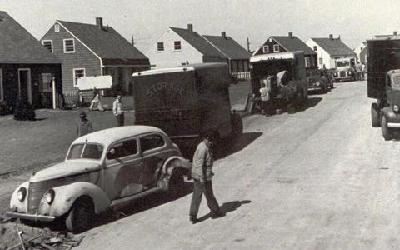
STEVE EMBER: Welcome to THE MAKING OF A NATION – American history in VOA Special English. I'm Steve Ember.
(MUSIC)
World War Two finally ended in August of 1945. Life in the United States began to return to normal. Soldiers began to come home and find jobs. Factories stopped producing war materials and began to produce goods for peacetime.
At the same time, other changes began to take place in society. Many Americans were no longer satisfied with their old ways of life. They wanted something new and better. And many were now earning enough money to find that better life.
Millions of Americans moved out of cities and small towns. They bought newly built homes in suburban communities outside busy cities. Today, we look at the growth of suburbs and other changes in the American population in the years after World War Two.
WIFE: "And we'll have the living room right in here, and the kitchen right here so we can see the children playing in the yard."
HUSBAND: "Yeah, the children ... Children? Say, how many are you planning on? Not more than six, I hope. Maybe I better add a few more rooms back here."
A married couple in a marketing film for the home building industry.
The United States counts its population every ten years. The first census took place in 1790. At that time, the country had about four million people. One hundred years later, in 1890, the population was 63 million.
By 1950, there were more than 150 million people living in the United States.
In the early years of America, the average mother had eight to ten children. Living conditions were hard. Many children died at an early age. Families needed a lot of help on the farm. So it was good to have many children.
But over the years birth rates fell. Families began to have fewer and fewer children. By 1900, the average woman had only three or four children. In 1936, during the Great Depression, the average American mother gave birth to only two children.
Things changed after World War Two.
(SOUND)
Suddenly, it seemed like every family started having babies. Parents were hopeful about the future. There were lots of jobs. People felt the need for a family and security after the long, difficult years of the war. From 1950 to 1960, the number of children between the ages of five and 14 increased by more than ten million.
The increase in births after the war produced what became known as the baby boom generation. An estimated 78 million Americans were born between 1946 and 1964.
Many of the new parents moved to homes in the new suburbs built outside the urban environment of cities.

Usually a developer would buy land, maybe from a farmer, then clear it, level it and build houses on it. Young families would buy the houses with money that they borrowed from local banks.
(MUSIC)
Life was different in the suburbs – calmer, less crowded than life in the big city. There were all sorts of group activities. There were Boy Scouts and Girl Scouts. Parent-Teacher Associations at school. Outdoor cooking where families gathered in someone's backyard to eat hamburgers hot off the grill.
Historian William Manchester described life in the suburbs in this way: The new suburbs were free, open, and honestly friendly to anyone except black people, whose time had not yet come.
Manchester wrote, Families moving in found that their new friends were happy to help them get started. Children in the suburbs exchanged toys and clothing almost as though they were group property. When little Bobby outgrew his clothes, his mother gave them to little Billy across the street.
People felt safe enough to leave their doors unlocked.
Parents did everything they could to make life good for their children. Between 1950 and 1960, the number of boys playing on Little League baseball teams increased from less than one million to almost six million. The number of Girl Scouts increased by two million. Bicycle sales doubled.
(SOUND: Chevrolet commercial)
And it wasn't just two-wheeled transportation that experienced a post war boost.
US new car production was stopped during World War Two, to allow those factories to produce airplanes, tanks, and other military vehicles for the war effort.
With the prosperity of peacetime, many Americans visited auto dealerships for the first time in years, to replace that tired family car with something more up to date -- even luxurious.
For many years, popular singer Dinah Shore invited optimistic post-war Americans to take to the highway and see their country in a Chevrolet.
(MUSIC)
Post war prosperity also led Americans to replace outdated home appliances, buy a new refrigerator, or a television set.
ANNOUNCER: "Come closer, sweetheart. Say, I don't think that's fair, because we can't get closer."
BETTY FURNESS: "Oh, but you could, if you had one of the new Westinghouse television sets with the exclusive Electronic Magnifier that gives you a big close-up image whenever you want it. All you do is turn the Electronic Magnifier knob, and there -- you get the heart of the picture. And see? I'm close enough to say, 'Hello, good looking!'"
Actress Betty Furness was commercial spokeswoman for Westinghouse.
RONALD REAGAN: "And every Sunday night, General Electric brings you the finest motion picture stars on TV -- the great names in comedy ... mystery ... romance. Every week, a star, all summer long, on the General Electric Theater."
STEVE EMBER: Over at competitor General Electric, actor Ronald Reagan -- later the 40th president of the United States -- and often referred to as the Great Communicator, was for many years an effective commercial spokesman every week on the GE Theater.
(MUSIC)
Parents also tried to improve their children's education. In 1960, parents bought almost three times as many educational books as they did ten years before.
Parents also bought millions of dollars' worth of pianos, violins and other musical instruments for their children.
It was true that the average number of children per family was increasing. But the total population of the United States did not increase as much during this period as one might have expected.
The reason for this was that fewer immigrants were coming to the United States. In fact, the number of immigrants had been dropping for many years. In 1910, 11 immigrants were coming to America for every thousand Americans already living here. By 1950, less than two immigrants were coming for every thousand Americans.
Where immigrants were coming from also changed. In the past, most came from northern and western Europe. But now, growing numbers of people came to the United States from southern and eastern Europe and from Latin America and Asia.
Other changes in the United States population were also taking place. In the 1950s, most Americans still lived in the eastern, central and southern parts of the country. But growing numbers moved west. The population of the western states increased by almost 40 percent during the 1950s.
Remember we said the United States population gets counted every ten years? One reason is because populations are used to decide how many members each state will have in the House of Representatives. Population changes can mean changes in the political influence of individual states in Congress.
(MUSIC)
Another population change after World War Two was in life expectancy. An American born in the early 1900s could only expect to live about 47 years. By the 1950s, however, most Americans could expect to live well past their 60th birthday.
Life expectancy continued to increase with improvements in living conditions and medical care.
The United States was a changing country, a nation on the move after World War Two. Next week on our program, we look at political events that shaped the post-war period.
Our program was written by David Jarmul. You can find our series online with transcripts, MP3s, podcasts and pictures at voaspecialenglish.com. You can also follow us on Facebook and Twitter at VOA Learning English. I'm Steve Ember, inviting you to join us again next week for THE MAKING OF A NATION -- American history in VOA Special English.
Westinghouse: 西屋電氣公司
American history: developing the first atomic bombs
American history: World War Two on the home front
American history: the war in the Pacific
American history: World War Two continues with the D-Day invasion in Normandy
(來源:VOA 編輯:崔旭燕)
